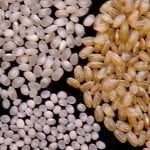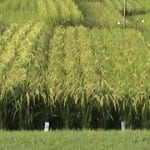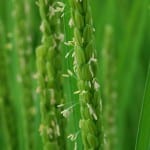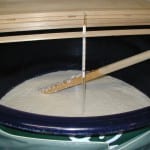 Sake is, as we all know, brewed from rice. Rice, in turn, is a very focused expression of soil, climate, and each year’s weather conditions such as sunshine, rain and typhoons. Every growing season is different, and there are good years for sake rice and bad years for sake rice.
Sake is, as we all know, brewed from rice. Rice, in turn, is a very focused expression of soil, climate, and each year’s weather conditions such as sunshine, rain and typhoons. Every growing season is different, and there are good years for sake rice and bad years for sake rice.
In most breweries, the toji (master brewer) will begin the brewing season with lower grades of sake. One goal in doing that is to be able to feel out the rice, to test it, to see how easily (or not) it will absorb water and, ultimately, dissolve into components while fermenting in the mash. The more easily it dissolves, the more flavor it will impart to the resulting sake. The less easily it dissolves, the lighter and more insipid the resulting sake will be. Finding the middle ground is key.
One great thing about sake brewing is that brewers can do a handful of things that can help the rice behave the way they want it to behave. In other words, they can make up for a bad year of rice and help the sake taste great again this year, at least to a certain degree. And naturally it helps tremendously if they know what is coming, and how to expect to have to deal with it.
 Wouldn’t it be great if someone analyzed it for them? Sure, brewers might know the weather of their immediate vicinity. But since rice can be brought in from other regions, wouldn’t it be great if the brewers could learn what to expect from each season’s rice, each of the main varieties of rice, from each region of Japan? Then they could use such data to determine how to tweak their brewing methods to adapt to each year’s and each region’s rice.
Wouldn’t it be great if someone analyzed it for them? Sure, brewers might know the weather of their immediate vicinity. But since rice can be brought in from other regions, wouldn’t it be great if the brewers could learn what to expect from each season’s rice, each of the main varieties of rice, from each region of Japan? Then they could use such data to determine how to tweak their brewing methods to adapt to each year’s and each region’s rice.
OK: Done.
The National Research Institute of Brewing is a research organization that has over its 110-year history been under the wing of multiple branches of the government of Japan, and also semi-privatized. Much could be written about this significant organization and what they do, and you can learn for yourself at www.nrib.go.jp if you like. But one thing they do each October is prepare a report for the brewing industry called the “Expected Suitability of This Year’s Rice to the Brewing Process.” (清酒原料米の酒造適性予測)
The short, four-page report talk firstly about its aim, which is explained above. It then runs down the average temperature in Japan for each ten day period in the two months of the growing season after the ears of rice appear, August and September, which are the key months related to the maturing of the grains. It briefly compares these to historical averages.
Next, the report runs down the eight major regions from northeast to southwest, commenting on the solubility of the rice for each, compared to both an average year, and to the previous year in particular
 Then, it waxes technical. It explains in excruciating detail how higher averages temperatures lead to longer Amylopectin (one of the two components of starch) chains. This means that the starches will dissolve very easily in the moromi (fermenting mash), which means more flavorful sake if controlled, but big-assed sloppy flavors if not reined in. It also accordingly means that resulting sake will be more susceptible to aging the adverse effects of aging.
Then, it waxes technical. It explains in excruciating detail how higher averages temperatures lead to longer Amylopectin (one of the two components of starch) chains. This means that the starches will dissolve very easily in the moromi (fermenting mash), which means more flavorful sake if controlled, but big-assed sloppy flavors if not reined in. It also accordingly means that resulting sake will be more susceptible to aging the adverse effects of aging.
Conversely, lower temperatures lead to shorter Amylopectin chains, meaning the starches will not dissolve very quickly or easily in the moromi, leading to lighter sake if done right, but tighter, shallower and less flavorful sake if its idiosyncrasies are not compensated for properly. Colder temperatures also lead to sake that will mature much more slowly, being reticent to give it up to the passage of time.
Curiously, one would think that the average reader of this report would not need to bone up on this stuff, so they must have had the intention of broadening the appeal of sake when they determined the content.
 Summer in Japan this year was again hot, just about as hot as last year was. The warmer temperatures of the past decade and then some have continued. Furthermore, the islands of Japan were pummeled with typhoons this fall, meaning lots and lots of rain. Factoring in all that and more, the prognosis was that this year’s rice will be not dissolve very well; not too bad, mind you. Just not so well.
Summer in Japan this year was again hot, just about as hot as last year was. The warmer temperatures of the past decade and then some have continued. Furthermore, the islands of Japan were pummeled with typhoons this fall, meaning lots and lots of rain. Factoring in all that and more, the prognosis was that this year’s rice will be not dissolve very well; not too bad, mind you. Just not so well.
What does this mean in more concrete terms? It means that the brewers will need to do things like help the rice absorb a bit more water than usual so that it dissolves a bit more easily. This will ensure that sufficient flavor presents itself.
However, fear not! All is not lost! So much is involved in the complex sake-brewing process that a skillful brewer can often make up for a bad rice crop with effort, experience and intuition. In fact, what brewers strive for year after year is consistency in their main products out on the market. Naturally, there are inevitable changes each year, but a truly skillful toji will minimize these.
 That’s the cool thing about sake: in making it, we can meet nature half-way. What will most noticeably suffer are the highest grades of sake, contest sake especially. But for most of us, what we will be drinking will be as good as it usually is; but we should not forget that added burden that will be on rice farmers and brewers to make it that way. Sake, like wine, remains an integral expression of nature.
That’s the cool thing about sake: in making it, we can meet nature half-way. What will most noticeably suffer are the highest grades of sake, contest sake especially. But for most of us, what we will be drinking will be as good as it usually is; but we should not forget that added burden that will be on rice farmers and brewers to make it that way. Sake, like wine, remains an integral expression of nature.
~~~~~~~~~~~~~~~~~~~~~~~~~~~~~~~~~~~~~~~~~~~~~~~~~~~~~~~~~~~~~~~~~~
Interested in sake? Check out my most recent book, Sake Confidential.





